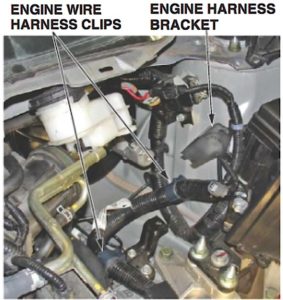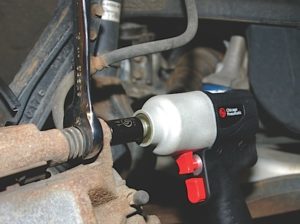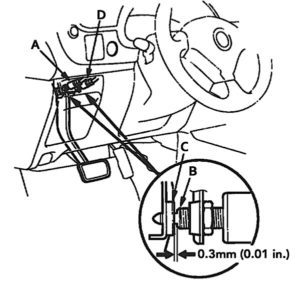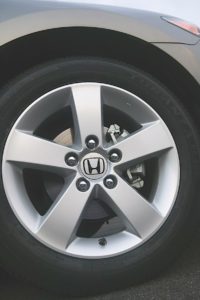Insight: Lightweight Rear Brake Drums
Older Insight models have a two-piece rear drum design with aluminum fins. This design has significantly reduced weight compared to cast-iron drums. The use of aluminum fins on the outside helps to assist with cooling. Machining this drum can be difficult, and all attempts should be made to remove as little material as possible to keep it within the 181mm service limit. Always do an inspection for cracks in the friction surface of the drum.
All Models: Darco Fasteners
Some Hondas have Darco-coated fasteners, which are incorporated into some caliper pins and bracket bolts to prevent corrosion. Replace them with similar fasteners that are coated or plated when installing new hardware.
Civic: Cold Start? High Altitude? Hard Pedal?
On some 2006-‘07 Civics, a cold-start condition in high altitudes may produce a hard brake pedal. This is due to a fast idle and low engine vacuum. The solution, according to Honda, is to replace the master cylinder rod seal and reprogram the engine module’s software so more vacuum is produced during high-idle conditions.

Pilot: Quick Booster Test
On the Pilot, or any Honda for that matter, if only one of the slider pins is seized or the pads are flexing in the bracket, the boost-assisted hydraulic system will have no problem forcing things to move.
A quick check for this problem is similar to the booster test. With the engine off, stroke the brake pedal to dump the vacuum. If the pedal feels good without boost, but you’re able to get excessive stroke with boost, suspect excessive movement somewhere.

Insight: IMA Brake Pedal Switch
The IMA system uses inputs from the brake pedal position switch and, on later models, an accelerometer to determine how much regenerative braking should be used. A properly adjusted brake pedal position switch can make a big difference in the operation of the regenerative braking system. If a customer complains that the regenerative brakes are grabby, readjusting the brake pedal position switch might solve this problem. Also, if the pedal is not properly adjusted, the engine idle shut off will not work properly.

Accord: Save Time By Removing One Bolt
Before removing the caliper guide pins on the seventh-generation Accord, remove the bolt that holds the front brake hose bracket on the knuckle before you start a brake job. It makes it easy to hang the caliper out of the way and service the pads and caliper bracket.
All Models With Rear Discs: Line Up The Notch on Rear Pads
On Hondas with rear disc brakes, make sure the notch in the rear caliper piston is lined up with the tab on the in-board rear brake pad. Failure to do this could make it difficult to reassemble the rear brake assembly and cost you time and money. It can also cause a long or mushy pedal.
Accord: Click or Pop When Pressing the Brake Pedal
Got an Accord (2003-’04) in your shop that clicks or pops when you press the brake pedal? The culprit could be the brake pedal position switch. The switch plunger doesn’t fit squarely into the switch casing. When you press the brake pedal, the plunger rubs the side of the casing and makes noise. There’s a simple fix for this problem: Turn the switch around so the connector lock faces the 5 o’clock position.
CR-V, Pilot: Rear Differential Mimics Brake Noise
A complaint often misdiagnosed as a brake problem is a noise coming from the rear when turning in the popular CR-V and Pilot models. This turning noise at low speeds is actually coming from the rear differential. On these models, only the Honda “dual pump” oil can be used. Changing the oil will take care of the noise.
All Models: Stuck ABS Sensors
You have to be careful with ABS sensors on most Hondas. If they’re stuck in the housing, it may be a better strategy to leave them in place and unplug them from the harness. But be careful with them as you work on the bench. Tip: Think about putting the job back together as you’re taking it apart.
All Models: Replace the Brake Hose if the Caliper Has Overheated
If you are replacing a caliper that has locked up and created a great deal of heat, you should also replace the brake hose. This is a good general practice, but particularly important with the Honda lineup, as there have been some instances of the hose failing at the caliper fitting after being subjected to the extreme heat.
All Models: Never Compromise on Pads
Most late-model Hondas are designed to work with ceramic friction formulations, so it’s critical that a similar friction material goes back on the vehicle. If an aggressive semi-metallic friction material is used, more heat could be transferred to the caliper piston, making it possible to boil the brake fluid.
The problem becomes even worse if you use a cheap brake pad set that does not include a set of shims. Honda engineers put a lot of effort into their shim designs to stop the vibrations in order for Honda vehicles to use a lighter caliper and knuckle to increase gas mileage and improve ride quality.
If you think you can out-engineer a bunch of Honda engineers with a cheap shim and tube of brake lube, you may have a comeback in the near future.
All Models: Better Brake Lubes
Brake lubricants are critical in returning a Honda’s brake system to an optimal operating condition. There are three criteria to remember when selecting brake lubricants. First, does it say that it is a brake lubricant on the package? If not, don’t use it. Some lubricants may say they are silicone- or molybdenum disulfide-based, but they may not be formulated to work on brakes. Second, look at the effective temperature range of the lubricant. At minimum, a lubricant should be able to handle 400º F on a Honda vehicle. Third, check to see if it contains petroleum distillates or any substance that can be detrimental to soft parts.

Accord: Rapid Rear Brake Pad Wear
Electronic brake proportioning (also called Electronic Brake Distribution or EBD) was introduced on some Honda models in 2006. Now, all 2011 and newer Honda vehicles, except the S2000, have EBD. With electronic brake proportioning, pressure from the master cylinder is routed equally to the front and rear brakes. There is no mechanical proportioning valve in the brake system. Instead, the anti-lock brake system (ABS) controls what happens at the brakes.
On some 2008-‘09 Honda Accords, the stock programming for the EBD system caused premature rear pad wear. Typically, the rear pads would last only 12,000 to 20,000 miles. The fix for this problem is a reflash of the ABS system and improved brake pads.
All Models: You Need Service Information
All Honda brake systems may look the same after awhile, but it is what’s unseen that can hurt you in the form of a comeback. It might be as simple as a torque specification for a caliper bracket, or as complex as a parking brake adjustment. Regardless, you need to have access to current repair information for most late-model Honda vehicles. If you use the Honda service information at techinfo.honda.com, take the time to look at the TSBs. It will be time well spent.














